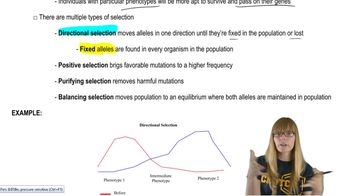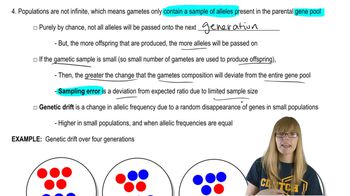Table of contents
- 1. Introduction to Genetics51m
- 2. Mendel's Laws of Inheritance3h 37m
- 3. Extensions to Mendelian Inheritance2h 41m
- 4. Genetic Mapping and Linkage2h 28m
- 5. Genetics of Bacteria and Viruses1h 21m
- 6. Chromosomal Variation1h 48m
- 7. DNA and Chromosome Structure56m
- 8. DNA Replication1h 10m
- 9. Mitosis and Meiosis1h 34m
- 10. Transcription1h 0m
- 11. Translation58m
- 12. Gene Regulation in Prokaryotes1h 19m
- 13. Gene Regulation in Eukaryotes44m
- 14. Genetic Control of Development44m
- 15. Genomes and Genomics1h 50m
- 16. Transposable Elements47m
- 17. Mutation, Repair, and Recombination1h 6m
- 18. Molecular Genetic Tools19m
- 19. Cancer Genetics29m
- 20. Quantitative Genetics1h 26m
- 21. Population Genetics50m
- 22. Evolutionary Genetics29m
21. Population Genetics
Allelic Frequency Changes
Problem 3
Textbook Question
Identify and describe the evolutionary forces that can cause allele frequencies to change from one generation to the next.
 Verified step by step guidance
Verified step by step guidance1
Identify the evolutionary force of natural selection, which can cause allele frequencies to change by favoring alleles that confer a survival or reproductive advantage.
Consider genetic drift, a random process that can lead to changes in allele frequencies, especially in small populations, due to chance events.
Examine gene flow, which involves the movement of alleles between populations through migration, potentially altering allele frequencies.
Explore mutation, a source of new alleles, which can introduce genetic variation and change allele frequencies over time.
Discuss non-random mating, where certain alleles may become more common if individuals preferentially mate with others that have specific genotypes.
Recommended similar problem, with video answer:
 Verified Solution
Verified SolutionThis video solution was recommended by our tutors as helpful for the problem above
Video duration:
2mPlay a video:
Was this helpful?
Key Concepts
Here are the essential concepts you must grasp in order to answer the question correctly.
Natural Selection
Natural selection is a process where individuals with favorable traits are more likely to survive and reproduce, leading to changes in allele frequencies over generations. This mechanism promotes the adaptation of populations to their environments, as advantageous alleles become more common while disadvantageous ones diminish.
Recommended video:
Guided course

Natural Selection
Genetic Drift
Genetic drift refers to random fluctuations in allele frequencies within a population, particularly in small populations. This stochastic process can lead to the loss of genetic variation and can cause alleles to become fixed or lost purely by chance, independent of their adaptive value.
Recommended video:
Guided course

Genetic Drift
Gene Flow
Gene flow, or gene migration, is the transfer of alleles or genes from one population to another through migration. This process can introduce new genetic material into a population, altering allele frequencies and increasing genetic diversity, which can have significant evolutionary implications.
Recommended video:
Guided course

Mapping Genes

 5:58m
5:58mWatch next
Master Natural Selection with a bite sized video explanation from Kylia Goodner
Start learning


